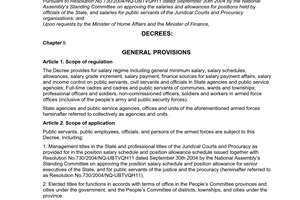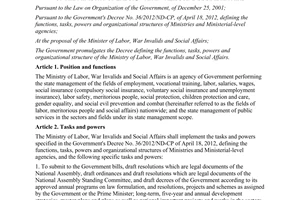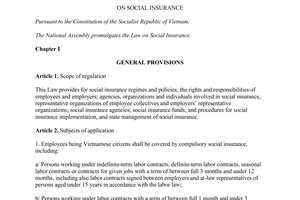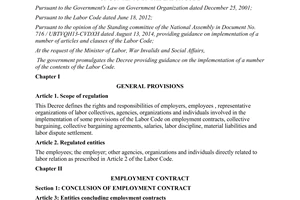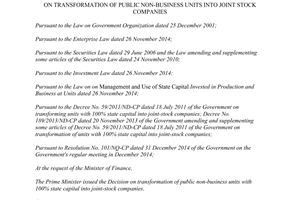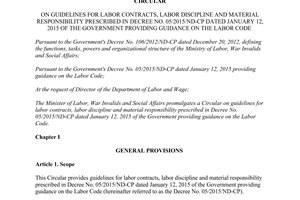Nội dung toàn văn Circular 35/2016/TT-BLDTBXH guidance implementation employee policies 22/2015/QD-TTg
|
MINISTRY OF
LABOR, WAR INVALIDS AND SOCIAL AFFAIRS |
SOCIALIST
REPUBLIC OF VIETNAM |
|
No.35/2016/TT-BLDTBXH |
Hanoi, October 25, 2016 |
CIRCULAR
PROVIDING GUIDANCE ON IMPLEMENTATION OF EMPLOYEE POLICIES IN THE CONTEXT OF TRANSFORMATION OF PUBLIC SERVICE ESTABLISHMENTS INTO JOINT-STOCK COMPANIES UNDER THE PRIME MINISTER’S DECISION NO. 22/2015/QD-TTG DATED JUNE 22, 2015
Pursuant to the Government's Decree No. 106/2012/ND-CP dated December 20, 2012, defining the functions, tasks, powers and organizational structure of the Ministry of Labor, War Invalids and Social Affairs;
Pursuant to the Prime Minister's Decision No. 22/2015/QD-TTg dated June 22, 2015 on transformation of public service establishments into joint-stock companies;
After considering the request of the Director of Labor and Payroll Department;
Upon implementation of the written order No. 2934/VPCP-DMDN of the Deputy Prime Minister Vuong Dinh Hue dated April 28, 2016 introduced by the Government's Office, the Minister of Labor, War Invalids and Social Affairs hereby provides guidance on implementation of employee policies in the context of transformation of public service establishments into joint-stock companies under the Prime Minister’s Decision No. 22/2015/QD-TTg dated June 22, 2015.
Article 1. Scope of application
This Circular gives guides to implementing the distribution of the residual cash amounts of the incentive, welfare fund or revenue of the reserve fund for income stabilization; the policy on purchase of preferred shares at preferential prices and additional stocks; the policy for employees who are made redundant due to transformation of public sector entities into joint-stock companies under the Prime Minister's Decision No. 22/2015/QD-TTg dated June 22, 2015 on transformation of public sector entities into joint-stock companies (hereinafter referred to as Decision No. 22/2015/QD-TTg)
Article 2. Subject of application
1. Employees working in public sector entities as of the date of their transformation into joint-stock companies (hereinafter referred to as transformed public service establishment), including:
a) Public officials or state employees holding positions as managers;
b) Contract state employees;
c) Employees working under terms and conditions of an employment contract referred to in the Government’s Decree No. 68/2000/ND-CP dated November 17, 2000 on applying specific forms of employment contract to certain work types existing in state administrative bodies or public service establishments;
d) Employees working under employment contracts referred to in the Labor Code.
2. Institutional and individual entities related to implementation of employee policies prescribed by this Circular.
Article 3. Definition
1. Redundant employee refers to persons listed as employees of a transformed public service establishment (irrespective of whether they are currently on duty or expecting work assignments) at the date of its transformation into a joint-stock company to whom it has failed in all attempts to assign work duties.
2. Employee utilization plan refers to an employee reassignment plan established by a transformed public service establishments, including major contents referred to in Article 46 of the Labor Code.
3. Employees appearing on the regular employee list of a transformed public service establishment refer to those who are currently on duty, on the payroll, on the list of employees eligible for social insurance contributions made by the transformed public service establishment; are dispatched to attend training courses or given its permission to attend classes; are on paid sick leave, maternity or paternity leave or take time off work to obtain medical treatment of their injuries or diseases resulting from accidents at work, or of occupational illnesses, in accordance with laws and regulations on labor and social insurance; are halted from their work through no fault of employees; are on unpaid leave with the agreement of the head of this establishment; are temporarily suspended from work, temporarily detained or jailed according to the competent state authority’s decision; are subject to the postponement of execution of employment or labor contracts.
Article 4. Distribution of the residual cash amounts of the incentive, welfare fund or revenue of the income stabilization fund
1. Employees that appear on the regular employee list of a transformed public service establishment as of the date of valuation of a transformed public service establishment (the date of closing of its accounting book, preparation of its financial statement for determination of value of that public service establishment) shall be entitled to distributions of the residual cash amount of the incentive, welfare fund (after offsetting payments in excess of benefits paid to employees), or revenue of the income stabilization fund (where available) in proportion to work term duration (number of years of employment or a full year) from the date of final recruitment into a transformed public service establishment to the date of valuation of the public service establishment for transformation into the joint-stock company. Distributing residual cash amounts of the incentive and welfare fund and revenue of the reserve fund for income stabilization in the fractional part of number of years of employment shall be subject to the transformed public service establishment’s decision.
2. The length of time of employment at the transformed public service establishment accepted as the basis for calculation of residual cash amounts of the incentive and welfare fund and revenue of the reserve fund for income stabilization includes the time period for which an employee has worked, probation or internship period before officially commencing work (where applicable); time period during which an employee has been sent to attend classes; time period during which an employee takes sick, maternity or paternity leave, or takes time off work for reasons of the medical treatment of any injury or illness due to accidents at work or occupational diseases as provided by laws on labor and social insurance; time period of weekly time-off or paid leave as stipulated by the Labor Code; time period during which an employee participates in trade union activities as prescribed by laws on labor and trade unions; time period during which an employee stops or leaves his/her work through no fault of his/her own; time period during which an employee is subject to temporary suspension, detention or imprisonment but is allowed to get back to work after obtaining a competent authority’s acquittal decision.
Article 5. Policy on purchase of shares at preferential prices or additional stocks
1. The policy on purchase of shares at preferential prices is provided for as follows:
a) Employees appearing on the regular employee list as of the date of announcement of value of a transformed public service establishment shall be entitled to purchase shares at preferential prices in proportion to the time period for which they have actually worked in the public sector (defined in years, full 12 months and with fractional months of the decimal number of years to be eliminated) in accordance with Clause 1 Article 21 of the Decision No. 22/2015/QD-TTg
b) The actual time length of employment in the public sector qualifying an employee for purchase of shares at preferential prices is measured as total of actual time length of employment in the public sector accrued as of the date of announcement of value of a public service establishment less the time length which has already been included prior to purchase of shares at preferential prices (at wholly state-owned enterprises implementing equitization procedures or public service establishments transformed into joint stock companies) and the time length which has already been included in calculation of retirement, work incapacity or one-time social insurance benefits (where applicable).
c) The actual time length of employment in the public sector is the total length of time during which an employee has actually worked for a transformed public service establishment, state administrative institution, political organization, socio-political institution and armed force unit, and has received salaries from the State Budget, or enterprises whose charter capital is wholly owned by the State, or other public service establishments before transferring to a transformed public service establishment.
The actual time length of employment in the public sector shall be calculated in the similar manner as provided by Clause 2 Article 4 hereof.
2. The policy on purchase of additional stocks shall be subject to regulations set forth in Article 21 of the Decision No. 22/2015/QD-TTg and instructions of the Ministry of Finance.
Article 6. Policy for redundant employees accepted through the final recruitment procedure into a transformed public service establishment before October 18, 2000
1. Redundant employees accepted through the final recruitment procedure into a transformed public service establishment before October 18, 2000 (the date of entry into force of the Government’s Resolution No. 16/2000/NQ-CP dated October 18, 2000 on downsizing of state administrative agencies and public service establishments) at the date of approval of the employee utilization plan shall be entitled to policies for redundant employees in accordance with Clause 1, 2, 3, and 4 Article 3 of the Government’s Decree No. 63/2015/ND-CP dealing with policies for redundant employees in the context of re-organization of state-owned single-member limited liability companies (hereinafter referred to as Decree No. 63/2015/ND-CP)
2. The time length of employment during which social insurance contribution is made as the basis for calculation of benefits paid to male redundant employees aged from 55 to 59 and female redundant employees aged from 50 to 54 who have reached at least 20 years of social insurance contribution (in accordance with Point c Clause 1 Article 3 of the Decree No. 63/2015/ND-CP) and to male redundant employees aged above 59 to under 60 and female redundant employees aged above 54 to under 55 who have reached at least 20 years of social insurance contribution (in accordance with Point b Clause 2 Article 3 of the Decree No. 63/2015/ND-CP) is the time length qualifying as the basis for payment of compulsory social insurance covers in accordance with laws and regulations on social security.
3. The time length of employment used for calculation of severance benefit or subsidy amounts paid to redundant employees referred to in Clause 4 Article 3 of the Decree No. 63/2015/ND-CP shall be determined as follows:
a) With respect to redundant employees accepted through the final recruitment procedure into a transformed public service establishment before January 1, 1995 (the date of entry into force of the 1994 Labor Code), the time length of employment used for calculation of severance benefit or subsidy amounts as prescribed by Point a and b Clause 4 Article 3 of the Decree No. 63/2015/ND-CP is the aggregation of the actual time length of employment from start of the final recruitment into a transformed public service establishment to termination of employment and the previous actual time length of employment in the public sector (where applicable), less the time length of an employee’s participation in unemployment insurance or the time length which has already been used for calculation of benefit payments upon army demobilization and reintegration after that employee has fulfilled their military obligations (where applicable).
The actual time length of employment in the public sector shall be calculated in the similar manner as provided by Point c Clause 1 Article 5 hereof.
b) With respect to redundant contract employees accepted through the final recruitment procedure into a transformed public service establishment from January 1, 1995 onwards, the time length of employment used for calculation of severance benefit or subsidy amounts as prescribed by Point a and b Clause 4 Article 3 of the Decree No. 63/2015/ND-CP is the sum of the actual time length of employment from start of the final recruitment of an employee into a transformed public service establishment to termination of employment less the time length of that employee’s participation in unemployment insurance or the time length which has already been used for calculation of benefit payments upon army demobilization and reintegration after that employee has fulfilled their military obligations (where applicable).
c) With respect to redundant public officials or state employees accepted through the final recruitment procedure into a transformed public service establishment from January 1, 1995 to the dates preceding December 3, 1998 (the date of entry into force of the Government’s Decree No. 96/1998/ND-CP dated November 17, 1998 on , the time length of employment used for calculation of severance benefit or subsidy amounts as prescribed by Point a and b Clause 4 Article 3 of the Decree No. 63/2015/ND-CP is the sum of the actual time length of employment from start of the final recruitment of an employee into a transformed public service establishment to termination of employment less the time length of that employee’s participation in unemployment insurance or the time length which has already been used for calculation of benefit payments upon army demobilization and reintegration after that employee has fulfilled their military obligations (where applicable).
With respect to redundant public officials or state employees accepted through the final recruitment procedure into a transformed public service establishment from December 3, 1998 to the dates preceding October 18, 2000, the time length of employment used for calculation of severance benefit or subsidy amounts as prescribed by Point a and b Clause 4 Article 3 of the Decree No. 63/2015/ND-CP is the aggregation of the time length of employment from start of the final recruitment of an employee into a transformed public service establishment to termination of employment less the time length of that employee’s participation in unemployment insurance or the time length which has already been used for calculation of severance pays or benefit payments upon army demobilization and reintegration after that employee has fulfilled their military obligations (where applicable).
4. Salary used for calculation of pension paid in each year of retirement prior to the statutory retirement age to redundant employees referred to in Point b Clause 1 of the Decree No. 63/2015/ND-CP shall be subject to the following regulations:
a) As for those referred to in Point a, b and c Clause 1 Article 2 of this Circular, such salary is wage, salary or related allowances, retained differences (where available) equivalent to work duties or titles classified according to the provisions of the Government’s Decree No. 204/2004/ND-CP dated December 14, 2004 on salary or wage policies for state officers, public officials, state employees and armed forces, which are equal to the average amounts paid for the period of 05 last years (60 last months) before termination of their employment.
b) As for those referred to in Point d Clause 1 Article 2 of this Circular, such salary is the average amount of salary or wage specified in employment contracts (including pay rate, salary-related allowances and other supplementary payments) which is paid in 05 last years (60 last months) prior to termination of employment.
5. The amount of salary or wage used as the basis for calculation of severance benefit or subsidy amounts paid to redundant employees referred to in Clause 4 Article 3 of the Decree No. 63/2015/ND-CP shall be subject to the following regulations:
a) As for those referred to in Point a, b and c Clause 1 Article 2 of this Circular, such salary is wage, salary or related allowances, retained differences (where available) equivalent to work duties or titles classified according to the provisions of the Government’s Decree No. 204/2004/ND-CP dated December 14, 2004 on salary or wage policies for state officers, public officials, state employees and armed forces, which are equal to the average amounts paid for the period of 06 last months before termination of their employment.
b) As for those referred to in Point d Clause 1 Article 2 of this Circular, such salary is the average amount of salary or wage specified in employment contracts (including pay rate, salary-related allowances and other supplementary payments) which is paid in 06 last months prior to termination of employment.
Salary specified in employment contracts refers to salary or wage stipulated by Clause 1, Point a Clause 2 and Point a Clause 3 Article 4 of the Circular No. 47/2015/TT-BLDTBXH dated November 16, 2015 of the Ministry of Labor, War Invalids and Social Affairs providing guidance on implementation of certain articles regarding employment contracts, labor disciplines and material responsibilities in the Government's Decree No. 05/2015/ND-CP dated January 12, 2015 on specific provisions and guidance on implementation of certain contents of the Labor Code.
Article 7. Policy for redundant employees accepted through the final recruitment procedure into a transformed public service establishment as from October 18, 2000 onwards
1. Redundant employees accepted through the final recruitment procedure into a transformed public service establishment as from October 18, 2000 to the date of approval of the employee utilization plan shall be entitled to severance benefits as provided by Clause 1 Article 4 of the Government’s Decree No. 63/2015/ND-CP.
2. The time length of employment used for calculation of payment of severance benefit amounts is the sum of the actual time length of employment from start of the final recruitment of an employee into a transformed public service establishment to termination of employment less the time length of that employee’s participation in unemployment insurance or the time length which has already been used for calculation of benefit payments upon army demobilization and reintegration after that employee has fulfilled their military obligations (where applicable).
3. Salary amounts used as the basis for calculation of payment of severance benefits shall conform to regulations laid down in Clause 5 Article 6 hereof.
Article 8. Implementation arrangements
1. The Steering Committee on transformation of public service establishments shall assume the following responsibilities:
a) Direct transformed public service establishments to draw up the employee utilization plan as prescribed in the Appendix 1 hereof, and ensure democracy, public disclosure and transparency and participation by the organization providing representation for employees working in these establishments.
b) Consolidate employee utilization alternatives as part of the public service transformation plan for submission to competent regulatory authorities to obtain their approval.
c) Request competent regulatory authorities to approve these employee utilization alternatives after obtaining the decision on approval of the public service establishment transformation plan; consolidate and request competent regulatory authorities to decide to make any modification to the employee utilization plan (where applicable).
a) Direct the transformed public service establishment to collaborate with the organization providing representation for employees to disseminate policies referred to in laws and regulations to employees working in the transformed public service establishment to implement them in a consistent manner; fully implement employee policies referred to herein.
2. The head of the transformed public service establishment shall assume the following responsibilities:
a) Draw up the employee utilization plan as prescribed in the Appendix hereto, and ensure democracy, public disclosure and transparency and participation by organizations providing representation for employees working in these establishments.
b) Collaborate with the organization providing representation for employees working in this establishment in disseminating these policies to implement them in a consistent manner; conduct implementation of these policies in accordance with provisions laid down in this Circular.
c) List and implement necessary procedures in order for social security authorities to pay social, health and unemployment insurance benefits as prescribed by laws and regulations; make all payments relating to employees' interest (where applicable); provide required benefits to employees in accordance with provisions laid down in this Circular.
d) Transfer the list and necessary documentation of employees to the Management Board or the General Director (Director) of the joint-stock company in accordance with provisions laid down in the Decision No. 22/2015/QD-TTg
dd) Submit the evaluation report on transformation of the public service establishment into the joint-stock company to competent regulatory authorities according to the Appendix 3 hereto within a maximum period of 30 days from the date on which all of the employee policies have been completely granted employees. The report must be made into 07 copies of which each is addressed to the authority in charge of approval of the transformation plan; the Ministry of Labor, War Invalids and Social Affairs; the Ministry of Finance; the Department of Labour, War Invalids and Social Affairs, the Trade Union at the higher level than the grassroots level of the administrative subdivision where the main office of the transformed public service is located; the Social Security authority of the administrative subdivision where the company makes social insurance contributions, and the remaining 1 copy is deposited to the joint-stock company.
3. Manager of the transformed public service establishment shall assume the following responsibilities:
a) Collaborate with the head of the transformed public service establishment and entities involved in implementing employee policies in accordance with this Circular.
b) Accept and utilize the number of transferees working for the joint-stock company as defined in the employee utilization plan and related documentation of employees.
c) Agree on any amendment or modification to employment contracts or enter into new employment contracts in accordance with laws on labor with respect to employees accepted to continue their work, those sent to take re-training courses before continuing their work or those who change to work under non-full-time employment contracts (where applicable) as defined in the employee utilization plan.
d) Prepare the list, documentation of employees and implement necessary procedures with related authorities in order to ensure these employees are accepted to continue their work, and pay social, health and unemployment insurance benefits to transferees to the joint-stock company in accordance with laws and regulations.
dd) Distribute the residual cash amounts of the reserve fund for income stabilization that remain at the date of transformation into the joint-stock company (where applicable) to employees working at the establishment at the date of valuation of this establishment in proportion to the number of years of employment in accordance with provisions set forth in Clause 9 Article 8 of the Decision No. 22/2015/QD-TTg and Article 4 hereof.
e) Inherit all interest, obligations and responsibilities of the public service establishment toward the number of transferees from this establishment in accordance with laws and regulations; if employees are subject to redundancy or severance after transformation into the joint-stock company as stipulated by laws on labor, employers shall be responsible for paying redundancy or severance benefits in proportion to the time length during which they have worked for them and employment termination benefits proportionate to the time length during which employees actually work for the transformed public service establishment or the time length during which they worked in the public sector prior to being accepted through the final recruitment procedure into the transformed public service establishment before December 3, 1998 with respect to employees who are public officials or state employees and before January 1, 1995 with respect to employees working under employment contracts prior to being recruited for work at the transformed public service establishment (where applicable).
g) Introduce regulations on recruitment and employee utilization; create labor productivity norms, pay scale, payroll, pay sheet and carry out pay rate modification and re-ranking activities; adopt rules and regulations on salary and bonus payment; internal labor rules; negotiate and conclude the collective bargaining agreement; build, issue and implement internal rules, occupational safety and hygiene processes and implement other regulations of laws on labor.
4. The social security authority of the administrative subdivisions where the transformed public service establishment makes social insurance contributions shall be responsible for guiding the transformed public service establishment to collect social insurance contributions and pay social insurance benefits to redundant employees who retire prior to reaching the statutory age; guiding the joint-stock company to implement social, health and unemployment insurance policies and provisions laid down in this Circular.
5. Ministries, Ministry-level bodies and government agencies, People’s Committees of centrally-affiliated cities and provinces, Board of Members of the parent company in the form of the economic corporation and state incorporations whose public service establishments are transformed into joint-stock companies shall take the following responsibilities:
Command the Steering Committee on transformation of public service establishments, the head of the transformed public service establishment and managers of the joint-stock companies to implement provisions laid down in this Circular.
b) Expedite, examine and oversee implementation of employee policies as prescribed by this Circular.
c) Consolidate and make a review report on employee policies at transformed public service establishments according to the Appendix 4 hereto and send it to the Ministry of Labor, War Invalids and Social Affairs and the Ministry of Finance for supervision and oversight purposes.
Article 9. Entry into force
This Circular shall enter into force from December 10, 2016.
In the course of implementation, if there is any difficult that arises, persons and entities concerned are advised to send their feedbacks to the Ministry of Labor, War Invalids and Social Affairs that decides to make any possible modification and further guidance.
|
PP. THE
MINISTER |
APPENDIX 1
FORMULATION OF THE EMPLOYEE UTILIZATION PLAN
(Issued together with the Circular No. 35/2016/TT-BLDTBXH
dated October 25, 2016 of the Ministry of Labor, War Invalids and Social
Affairs)
After obtaining the decision on approval of the list and plan for transformation of public service establishments, the Steering Committee on equitization of transformed public service establishments shall establish the plan for employee utilization (included in the plan for transformation of public service establishments) according to the following steps:
1. Step 1: Compile the list of all employees working for the transformed public service establishment at the date of valuation thereof (according to the form No. 1 in the Appendix 2 issued together with this Circular) and at the date of announcement of value of the transformed public service establishment (according to the form No. 2 in the Appendix 2 issued together with this Circular), including:
a) Employees currently on duty, appearing on the payroll, and making social insurance contributions, of the transformed public service establishment (including employees on probation);
b) Employees currently sent to join courses or granted permission to join training courses;
c) Employees currently on sick, maternity or paternity leave, or taking time off work to take medical treatment of their injuries or illnesses due to accidents at work or occupational diseases in accordance with laws and regulations on labor and social insurance;
d) Employees currently having to leave their work through no fault of their own;
dd) Employees currently taking unpaid leave without consent from the head of their host establishment;
e) Employees currently subject to temporary suspension or detention or imprisonment in accordance with the decision granted by a competent regulatory authority;
g) Employees currently subject to a postponement of execution of labor or employment contracts.
2. Step 2: Compile the list of all transferees to joint-stock companies (according to the form No. 3 in the Appendix 2 issued together with this Circular), including:
a) Those accepted to continue their work;
b) Those that must be re-trained to be eligible to continue their work (where possible);
c) Those changing to work in the form of non-full-time employment (where applicable).
3. Step 3: Compile the list of all employees leaving their work at the date of transformation into the joint-stock company (according to the form No. 4 in the Appendix 2 issued together with this Circular), including:
a) Employees that meet retirement requirements in accordance with laws and regulations on social insurance.
b) Employees with whom employment or labor contracts have expired, or who unilaterally terminate employment or labor contracts.
c) Employees whom the public service establishment has failed in all attempts to assign proper work duties in the joint-stock company at the date of transformation (hereinafter referred to as redundant employee).
4. Step 4: Compile the list of all redundant employees existing at the date of transformation into the joint-stock company (according to the form No. 5 in the Appendix 2 issued together with this Circular), including:
a) Redundant employees accepted through the final recruitment procedure into the transformed public service establishment before October 18, 2000:
- Male redundant employees aged from 55 to 59 and female redundant employees aged from 50 to 54 who have reached at least 20 years of social insurance contribution.
- Male redundant employees aged from above 59 to under 60 and female redundant employees aged from above 54 to under 55 who have reached at least 20 years of social insurance contribution.
- Employees who reach statutory retirement age as provided by Point a Clause 1 Article 54 of the 2014 Law on Social Insurance, but have no more than 06 months of social insurance contribution left to be eligible for receiving pension benefits.
- Redundant employees who have to leave their work or terminate employment or labor contracts.
b) Redundant employees accepted through the final recruitment procedure into the transformed public service establishment as from October 18, 2000 onwards.
5. Step 5. Set the specific time at which employees have to leave their work or terminate employment or labor contract, and pay benefits to redundant employees accepted through the final recruitment procedure before October 18, 2000.
- Redundant employees that retire before reaching the statutory retirement age (according to the form No. 6 in the Appendix 2 issued together with this Circular).
- Employees that reach the statutory retirement age but have lack of no more than 06 months of social insurance contribution to be eligible for retirement benefits (according to the form No. 7 in the Appendix 2 issued together with this Circular).
- Redundant employees who have to leave their work or terminate employment or labor contracts (according to the form No. 8 in the Appendix 2 issued together with this Circular).
6. Step 6. Set the specific time at which redundant employees accepted through the final recruitment procedure occurring from October 18, 2000 onwards have to leave their work or terminate employment or labor contract (according to the form No. 9 in the Appendix 2 issued together with this Circular).
7. Step 7. Consolidate the plans for employee utilization according to the form No. 2 issued together with this Circular./.
------------------------------------------------------------------------------------------------------
This translation is made by LawSoft and
for reference purposes only. Its copyright is owned by LawSoft
and protected under Clause 2, Article 14 of the Law on Intellectual Property.Your comments are always welcomed
